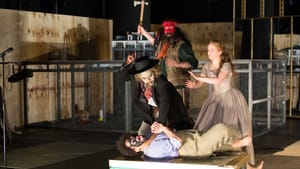Stay in the Loop
BSR publishes on a weekly schedule, with an email newsletter every Wednesday and Thursday morning. There’s no paywall, and subscribing is always free.
Looking in a funny mirror
'An Octoroon' at the Wilma (first review)

"I can't even wipe my ass without being accused of deconstructing the race problem," says the character BJJ (who shares his initials with playwright Branden Jacobs-Jenkins) in An Octoroon at the Wilma Theater.
His justified diatribe is about blacks in American theater today: they're not considered equal, their work and even their presence is seen as a commentary about race, and they're just not seen enough. "Give me a fucking break," BJJ says, "and by a break, I mean a production."
He gets it and more in a daring and inventive staging directed by the University of the Arts's head of theater, Joanna Settle. She supports and enlightens Jacobs-Jenkins's already provocative play, which includes a stylized interpretation of Dion Boucicault's 1859 melodrama The Octoroon; original live music by ILL DOOTS (who were a hit in Settle's Flashpoint Theatre Company production of Hands Up last summer); a superb cast led by Philadelphia playwright, director, and actor James Ijames as BJJ; and the Wilma's typically stunning design work.
An ironic illumination
The Octoroon would be fascinating to see in a more straightforward production, but filtered thorough Jacob-Jenkins' modern sensibilities, its seemingly ridiculous story of forbidden love on a plantation illuminates today's continuing racial issues — ironically, the very thing BJJ professes to disdain.
Ijames begins the play in his underwear, sharing his thoughts with us as he prepares to play both kindly slave owner George and evil rival M'Closky in whiteface make-up. He's joined by Ed Swidey as "Playwright," Irish immigrant Boucicault, who berates the audience with his own frustrations about theater. (In 1859 New York City, he couldn't use black actors, for example.) Swidey dons bright red makeup to play Native American Wahnotee, and Justin Jain applies blackface to play two sympathetic slaves.
In The Octoroon, George is fancied by blonde white heiress Dora (Maggie Johnson), but falls for Zoe (Campbell O'Hare), who must reveal her "dark fatal mark of Cain . . . One drop in eight [of her blood] is black." She was freed by her late white father, but is the illegitimate product of his relationship with Zoe's mother, a quadroon. In antebellum America, a one-eighth black person — an octoroon — was considered black and therefore less than human, Boucicault's dialogue shows: "I am an unclean thing," Zoe confesses. The law, not her heritage, is what brands her as inferior.
Through a series of shady machinations, M'Closky discovers Zoe's secret, and that her freedom is invalid due to a lien on the plantation. He plots to buy the property — and Zoe.
The play in the present
Jacob-Jenkins pulls The Octoroon into today with the fun device of allowing three slaves — played by black performers Taysha Canales, Jaylene Clark Owens, and Alina John — to speak in modern slang and attitudes. "Cool-ass white people," one calls their former owners, "it could have been worse." One has a mixed-race baby, played by a white doll in blackface.
An Octoroon successfully balances serious issues — the consideration of Boucicault's play today and BJJ's insights — with Settle's theatrical flourishes, which make the play palatable with often outrageous comedy. For example, when George and M'Closky meet in a climactic showdown, Ijames plays both simultaneously, wearing a costume that's one character on the left, the other on the right. Fight director Ian Rose makes their battle hilarious while still suspenseful and violent. More dramatic is a single haunting photograph, projected on a plastic curtain, that we're forced to contemplate, reminding us that what drives An Octoroon is not melodrama, music, or meditations about modern life, but an inescapable haunting reality.
Forcing us to see ourselves
Settle highlights the play's Brechtian flourishes not only with ILL DOOTS' wry commentary and emotional underscoring, but Matt Saunders's vast set, which fences the play in plywood, and includes ripped-up holes in the floor, a chicken coop with real chickens (which becomes a slave pen), a small model of the plantation mansion, a platform on tracks which moves to center stage for the slave auction, and mirrors that force us to see ourselves. Thom Weaver's lighting sometimes feels like naked work lights, and then surprises with beautiful flourishes. Tilly Grimes's costumes cleverly mock the 1850s.
The spectacle of it all — from the multiracial face painting and pounding live music to the deliberately unrepresentative scenery and the mix of Boucicault's melodramatic dialogue and Jacob-Jenkins' caustic commentary on modern issues — demands attention and causes excitement.
Outside the theater, though, the disturbing realities of slavery and racist America stick in our minds.
For Rhonda Davis's review, click here.
What, When, Where
An Octoroon by Brandon Jacobs-Jenkins, directed by Joanna Settle. Through April 10 at the Wilma Theater, Broad & Spruce Streets, Philadelphia. 215-564-7824 or wilmatheater.org.
Sign up for our newsletter
All of the week's new articles, all in one place. Sign up for the free weekly BSR newsletters, and don't miss a conversation.

 Mark Cofta
Mark Cofta